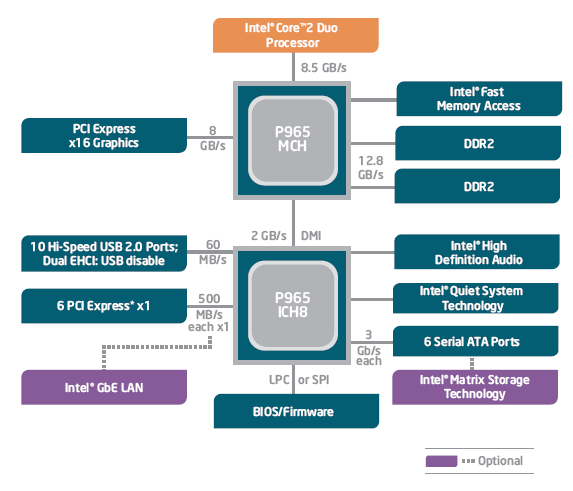Intel P965 chipset examination
Intel P965 chipset (Broadwater)
What marks this motherboard out from any that we have reviewed in the past? The answer is a new chipset from Intel, the P965. Intel is planning on releasing three variants. The P965 differs from the G965 by not sporting integrated graphics. The latter is especially geared towards Intel's multimedia Viiv platform, then. The Q965, which will be released later this summer, is the business equivalent, supporting vPro. Coming back to the P965, let's haul out the ever-so-help chipset block diagram and assess what's new.

Let's start at the top and work our way down. Our Intel Core 2 Duo/Extreme review's performance numbers were gained by running Intel's new processors on a modified Intel i975X (Bad Axe) chipset-based motherboard. The differing power requirements for Conroe/Core 2 Duo/Extreme requires a little hardware modification to most i975X boards, and IHVs have been listing Conroe-supporting (post-modification) boards for a while now.
The 965-Express family of chipsets, though, provide native Core 2 Duo support right out of the box, hence why you see the diagram with Core 2 Duo at the helm. The processors still interact with the northbridge via an 8.5GB/s interconnect. The P965 MCH also brings native dual-channel DDR2-800 memory support, offering, potentially, 12.8GB/s of juicy bandwidth to the system.
Keeping memory subsystem performance ticking over is what Intel terms Fast Memory Access, which encompasses a bunch of technologies designed to maximise memory performance. Key points include just in time scheduling, where bandwidth is maximised by intelligently monitoring pending accesses and loading up the system bus as early as possible. FMA also includes out-of-order execution, which, as the name suggests, allows the MCH to re-order the data stream for maximum performance, much in the way modern CPUs do. Further, opportunistic writes (intelligent guessing and writing of memory requests during idle periods) and clock-crossing optimisations (reducing latency when having to buffer between differing FSB and memory frequencies) should ensure that P965 is no slouch in the performance department. Indeed, if an IHV optimises it correctly it could be a touch faster than i975X.
Looking across to the left, we see that P965 supports a regular PCIe x16 graphics card, just as you would expect. It's what's left out that's telling. There's no current provision for multi-GPU support for ATI's CrossFire tech. That's left to the more-expensive i975X. We find it odd that Intel debuts its first native Core 2 Duo-supporting chipset without CrossFire support.
The P965 MCH is paired to an all-new southbridge via the same 2GB/s DMI interconnect as found on i975X. Again, it's what's missing that's telling. Intel initiated the demise of PATA by specifying its ICH7R southbridge with only a single PATA channel, stating, unequivocally, that SATA is where storage is heading towards. The ICH8(R), then, does away with PATA completely, and it will be up to motherboard designers, if they so wish, to add in a PATA-supporting ASIC. As you can see from the Gigabyte's spec. sheet, that's exactly what it's done.
The P965 raises the USB 2.0 count up to 10, matching other modern chipsets. PCIe support stays at an i975X-like 6 x1 slots, although we've yet to see any consumer motherboard sport more than 3: there's only so much space available on ATX-sized motherboards and IHVs tend to favour adding in PCIe ASICs for networking. Speaking of which, there's an optional (usually expensive to implement) Intel GbE LAN option. We expect a number of IHVs to opt for lower-cost solutions from the likes of Marvell, which is exactly what Gigabyte has done with its DQ6.
High-definition audio is carried over from ICH7(R) and Intel's Matrix Storage Technology is now expanded to include support for up to 6 SATA2 drives, with RAID offered in 0,1,5 and 10 flavours. Additionally and interesting, Intel has provided support for external SATA (eSATA), although you'll have to sacrifice one of the internal ports for it to be implemented.
With Core 2 Duo offering prodigious performance with relatively low TDPs, Intel has endowed the 965-Express series with what it terms Quiet System Technology, whereby fan speeds are controlled in relation to the system and CPU's temperature. The premise is to keep noise to a minimal whilst ensuring the system doesn't overheat and throttle performance. Why run a fan at full speed if 60% offers enough cooling for the system to keep ticking away without impinging on performance?
Readers with a keen eye on chipset evolution will note that the 965-Express series isn't designed to replace the incumbent i975X as performance/feature leader. The i975X chipset is geared towards the high-end enthusiast sector and, in part, at the workstation market. That's why it will continue to ship with multi-GPU support and Intel's Active Management Technology. Both of these features are missing from the P965.
We expect to see a number of mid-priced motherboards based on P965. Gigabyte, though, has chosen to run with all the bells and whistles with its GA-965P-DQ6. It does, of course, offer cheaper, less-featured models equipped with P965.









